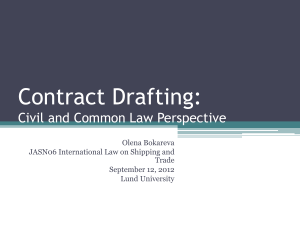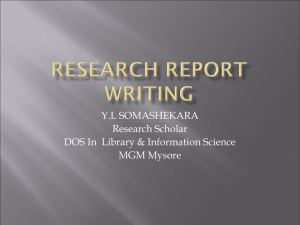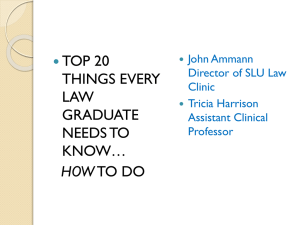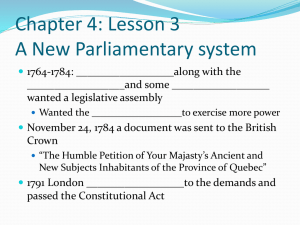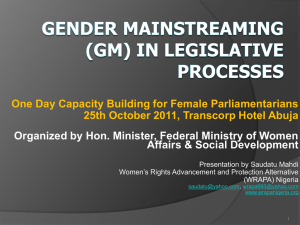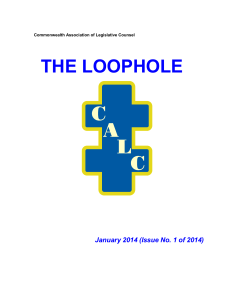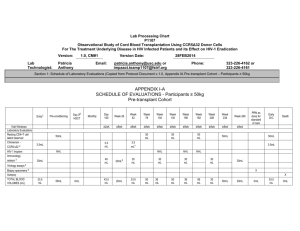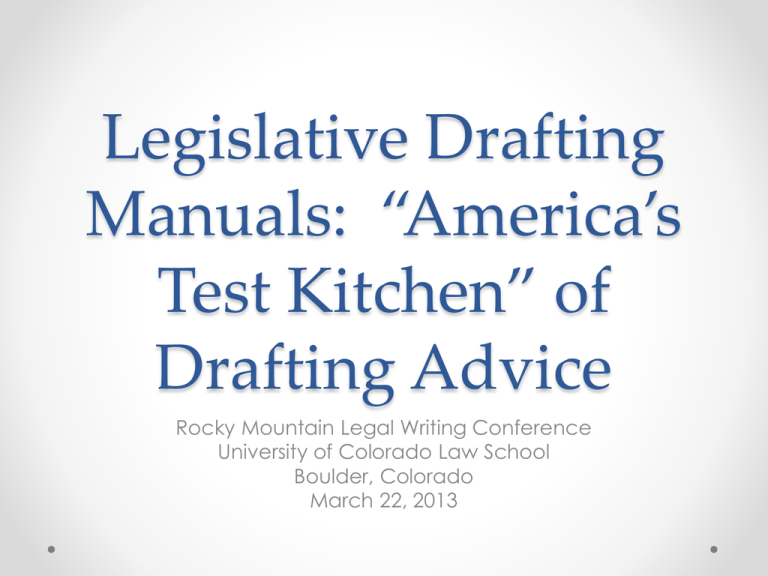
Legislative Drafting
Manuals: “America’s
Test Kitchen” of
Drafting Advice
Rocky Mountain Legal Writing Conference
University of Colorado Law School
Boulder, Colorado
March 22, 2013
Why look at legislative
drafting manuals (LDMs)?
• Student interest in drafting instruction is up.
o Opportunities in upper-level writing
courses, live-client clinics, and discrete
exercises in other courses.
• LDMs are great style reference materials.
o Free, online, often with good
explanations.
• LDMs are rich sources of drafting examples.
o Reinforce examples in assigned text.
But I teach contract drafting,
not legislative drafting . . . .
• Definitions
• Words of authority
• Plain language
• Research
• Organization
• Forms—benefits and limits
U.S. Legislative Drafting
Manuals
• 33 available free, online
• Content varies.
• One-stop page to find them all:
o National Council of State Legislatures, “Bill
drafting” page
o http://www.ncsl.org/legislativestaff/lsss/bill-drafting-manuals.aspx
Legislative Drafting
Manuals
Ways to use LDMs
(from less effort to more effort)
1.
2.
3.
4.
List in syllabus as style reference materials.
Refer to in feedback on student papers.
Include excerpts in Course Supplement.
Mine for examples during class
presentation.
5. Use for in-class exercises, about revision, for
example.
Using LDM examples in
class
• Serial comma
• Shall / must (also shall not / may
not)
My top five LDMs
For drafting assignments (contracts and statutes), I find even the best legal writing style
manuals to be very limited. Drafting is just that precise. Consult the . . . text first. If you
want additional guidance (such as, about how to use “shall” or how to tabulate a list),
legislative drafting manuals for the following states are available online and offer
helpful examples and explanations:
•
•
•
•
•
Colorado: Office of Legislative Legal Services, Colorado Legislative Drafting
Manual (2009, with 2011 updates available online only), available at
http://www.state.co.us/gov_dir/leg_dir/olls/legislative_drafting_manual.htm
Idaho: Idaho Legislative Services Office, Legislation Drafting Manual: Concise
Version (2011), available at http://legislature.idaho.gov/about/draftingmanual.pdf
Maine: Office of the Revisor of Statutes, Maine Legislative Drafting Manual (2009),
available at http://www.maine.gov/legis/ros/manual/Draftman2009.pdf
Minnesota: Office of the Revisor of Statutes, Minnesota Revisor’s Manual (2002),
available at
https://www.revisor.mn.gov/revisor/pubs/bill_drafting_manual/revisor_manual.pdf
Montana: Montana Legislative Services Division, Bill Drafting Manual (2010),
available at http://leg.mt.gov/content/Publications/2010-bill-drafting-manual.pdf
To be clear, these legislative drafting manuals are only supplemental reference
materials. They are optional; you are not required to download or print any of them
(they are large documents). The only required texts for the course are . . . .
Ideas for a Course Supplement
(handout)
• Research checklist (Massachusetts) (but
modify)
• Style checklist (Arizona, Idaho)
• Sample bills (Arkansas, South Dakota)
• Introduction to interpretation (Florida
(Senate), Minnesota, Oregon, West Virginia)
• Special topic: words of authority (Maine)
• Special topic: “Indian issues” (Montana)
Can punctuation ever be
fun?
Among those interviewed were his two
ex-wives, Kris Kristofferson and Robert
Duvall.
Punctuation—the serial comma
(a.k.a. Oxford comma)
• The woods are lovely, dark, and deep.
• The woods are lovely, dark and deep.
o Same meaning as above?
or
o “lovely” means “dark and deep”
Punctuation—which one has the
(potentially) fatal ambiguity?
• To my parents, Ayn Rand and God
• To my parents, Ayn Rand, and God
What students learn
before law school
• red, white and blue
• The patient can be given penicillin,
ampicillin, or erythromycin.
Drafting is different.
• The magazine company listed jobs in
accounting, subscriptions and advertising
and public relations.
• My estate is to be divided equally among
my nephew, my son, my daughter, and my
son-in-law.
Minnesota manual’s
explanation
The revisor's office uses a style that calls for a comma
before the conjunction in a series. . . . A drafter should
think carefully, though, before adding a comma to a
sentence written by someone else. In rare cases, such a
sentence may be ambiguous. Here is an example:
o The commissioner shall assign to the case two managers, a program specialist
and a family visitor.
How many people are being assigned to the case?
Without a comma, the sentence can be read to mean two
or four people. Make certain that the original drafter
meant four people before adding the comma. (If the
drafter meant two people, rewrite the sentence.)
Minority position: no
serial commas allowed
• Arizona, Maine, Massachusetts, New
Mexico, Oregon, South Dakota, and West
Virginia
• If the LDM bans serial commas, what effect
on a court’s interpretation? So far, none.
o Enterprise means any corporation,
partnership, association, labor union or
other legal entity, or any group of persons
associated in fact although not a legal
entity, that is involved with providing care
to a vulnerable adult.
Bigger question: should
courts consider LDMs?
• Carr v. United States, 130 S. Ct. 2229, 2245 (2010)
(Alito, J. dissenting)
• Issue was verb tense in sex offender registration
statute.
• Dissent saw LDMs as showing the convention
among professional legislative drafters.
• Quoted LDMs from Colorado, Hawaii, Kentucky,
Maine, Massachusetts, New Mexico, Texas, West
Virginia, and Ohio.
Serial comma wrap-up
• New rules: before law school, students
may have learned something different.
• Drafting fundamental: avoid
ambiguity.
• Broader question: should courts
consider LDMs when interpreting
statutes?
Words of Authority
• Shall
• Must
• Avoid ambiguity
• Golden Rule of Drafting
• Accountability: who has a duty to do
what?
LDMs on words of
authority
• Consensus on the basic principles
o “Shall” creates duty; “shall” does not
show futurity.
o Avoid false imperatives.
o Be consistent.
• Variety of pedagogical approaches
• Some examples that provide
teachable moments
Grammar focus
“Shall is used to qualify an active verb.
Must is used to qualify an inactive verb
or an inactive verb in the passive voice.”
–North Dakota bill drafting manual
Flowchart approach
What follows is a short rule that drafters can apply to
help them use shall and must consistently with our
recommendations.
Either shall or must may be used if all of the following
conditions are satisfied:
(1) The statement imposes a duty or prohibition.
(2) The subject of the sentence is a human being or
legal entity.
(3) The duty or prohibition is imposed in the active voice.
If all conditions are not met, use must to impose a duty,
prohibition, obligation, requirement, status, or condition.
List approach
To create a right, say “is entitled to.”
To create discretionary authority, say “may.”
To create a duty, say “shall.”
To create a condition precedent, say “must.”
To negate a right, say “is not entitled to.”
To negate discretionary authority, say “may not.”
To negate a duty or a mere condition precedent,
say “is not required to.”
• To create a duty not to act, say “shall not.”
•
•
•
•
•
•
•
Paired examples approach
Do not use
Use Instead
It shall be unlawful
If a member shall resign
The term “person” shall
mean
It is unlawful
If a member resigns
“Person” means
The equipment shall remain
the property of the lessor
No person shall be entitled
The equipment remains the
property of the lessor
No person is entitled
This section shall not be
construed
Who shall serve
This section does not
Who serves
Straightforward
explanation
“Shall not” is used throughout the Idaho Code and it
may be difficult to break that tradition. However,
“shall not” means that a person does not have a duty
to act. To say “no person shall” means that there is no
one who has a duty to engage in the action. The
proper way to prohibit an act is to say “may not” in
connection with the action prohibited: “The board
may not revoke a license without a hearing.” “May
not” properly denies the board the authority to act in
that situation.
Neither shall nor must
A drafter might also choose a drafting approach that
eliminates the decision of whether to use “shall” or
“must.” Under this approach, the provision simply
states a legal fact.
• The appointee qualifies for office by taking the
official oath and filing the required bond. (The
method by which the appointee qualifies for office
is stated as a factual matter.)
Teachable moments
• Preferred:
o The judge must receive the
application by the deadline.
• Avoid:
o The judge shall receive the
application by the deadline.
LDMs for in-class
exercises
• Narrow topic
o Definitions (see handout)
o Severability / non-severability clauses
• Copy or modify examples in LDMs
• Students critique
Questions
• Have you used legislative drafting
manuals?
• How many samples is too many?
• How are students learning about
drafting in your school’s curriculum?

